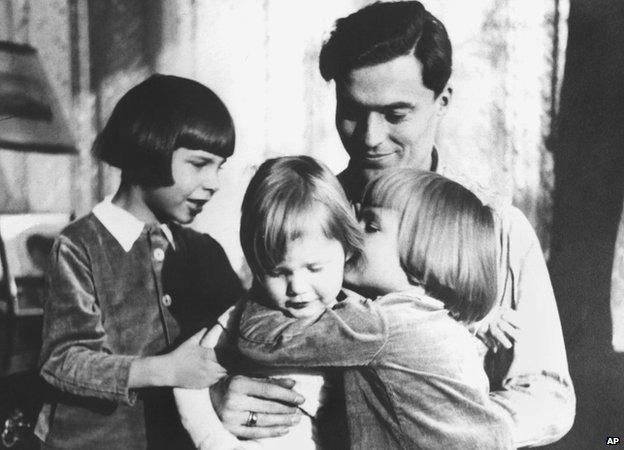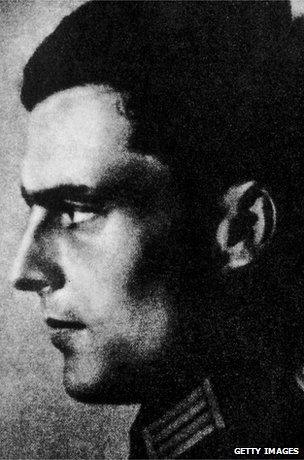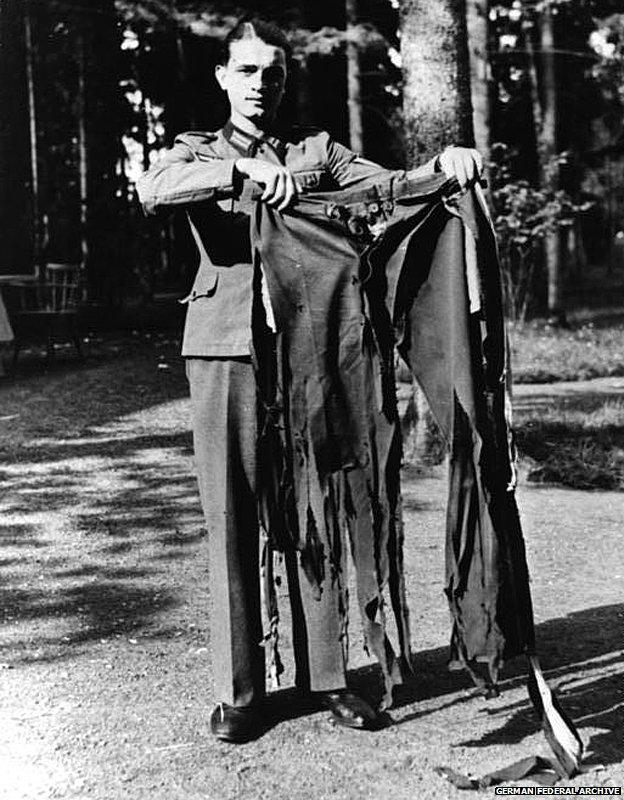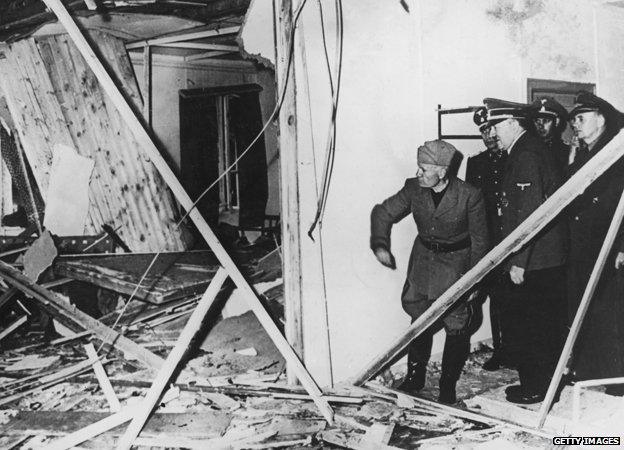The German officer who tried to kill Hitler
- Published

On 20 July 1944, a 36-year-old German army officer, Col Claus Schenk Graf von Stauffenberg, arrived at a heavily guarded complex hidden in a forest in East Prussia. His mission was to kill Adolf Hitler.
The Wolfsschanze, or Wolf's Lair, was Hitler's secret headquarters on the Eastern Front. Stauffenberg was attending the daily briefing between the Fuhrer and Germany's high command - but in his briefcase, he carried a bomb.
"We were standing around and Hitler came in, and then the conference began," recalled German army officer Gen Walter Warlimont in a BBC interview in 1967.
"Suddenly the door opened again, and I happened to turn around, and I saw that a colonel came in... he made a very deep impression on me, because his right eye was covered by a black patch and one arm was amputated, and he stood there quite erect, and he seemed to me to be the picture of a classical soldier."
"Hitler turned around and looked at him without any kind of benevolence and [Gen] Keitel introduced him."

Stauffenberg was an aristocratic, Catholic, career army officer. "Everyone says my father was extremely good looking - dark hair, blue eyes, slightly wavy hair, tall. He was a very cheerful man, he used to laugh a lot and we thought he was absolutely wonderful," says his son, Berthold Schenk Graf von Stauffenberg, who's now 80 years old.
In 1943, Stauffenberg was badly injured while serving in Tunisia - he'd lost an eye, his right hand, and two fingers from his left hand.
"You know wounds were so commonplace at the time and having lost an arm, having lost an eye, was quite normal. It was really a relief that he was alive," says Berthold.
Though not overtly political, Stauffenberg was a conservative and a nationalist. At times, he had supported Nazi policies, but as the war progressed, his opposition to the regime grew - he was horrified by German atrocities in the east and the realisation that Germany was losing the war.
"He was disenchanted with Hitler's strategic capabilities and that really Hitler was a different type of person from what we thought acceptable," says Berthold.
"I was a boy of 10, very interested in what was going on in the world. I was just about to become a little Nazi, like all of us. But we never discussed that with my father or my mother. If he had discussed politics with us he couldn't have shown his real feelings because it would have been too dangerous. Children give things away."
As he recovered from his injuries, Stauffenberg was approached by a group of conspirators led by Gen Henning von Tresckow, who wanted to kill Hitler and overthrow the Nazi regime. Stauffenberg became a leading member of the plot.
In the months that followed there were several abortive attempts to kill Hitler and there was a growing fear that the Gestapo was closing in on the conspirators.
But in 1944, Stauffenberg became chief of staff for the commander of the German Replacement Army. The post gave him access to Hitler and an opportunity to carry out the assassination.
.jpg)
A bust of Claus von Stauffenberg at the German Resistance Memorial Center
The conspirators' plan was fraught with risk. Stauffenberg would carry explosives in his briefcase, through the security checks surrounding the Wolf's Lair, prime the bomb and place his briefcase near Hitler during the daily briefing. He would then make his excuses and leave the room. After the explosion, Stauffenberg would dash back to Berlin where the conspirators would use the Replacement Army to take control.
"They were not sure they would succeed but Tresckow said the attack on Hitler must go on, if only to prove that not all Germans were his followers," says Berthold.
But if the plot failed, it was not just the conspirators who would be at risk. "My mother always said she knew what was planned. She'd found out and confronted my father and so he told her. But she didn't know that he was to plant the bomb."
"They knew the consequences, but in times of war, life is not as important as it is now in a peacetime environment. People die all the time and to sacrifice oneself seems to be an enormous thing, but in wartime it's different."
On Thursday 20 July, Stauffenberg arrived at the Wolf's Lair - the briefing was set for 12:30. But he was interrupted as he tried to set the bomb, so he put only one of two explosive devices in his briefcase before he entered the meeting.
"I remember that Stauffenberg had a big black briefcase under his good arm," said Warlimont in 1967.
"But then I didn't look at him anymore, so I didn't see him putting it under the table, or leaving the room shortly afterwards. About five to 10 minutes passed - I had forgotten about him when the explosion happened."

The trousers Hitler was wearing when the bomb exploded
Stauffenberg saw the explosion as he left the compound to head back to Berlin. He was sure that Hitler was dead.
But just before the explosion, Stauffenberg's briefcase had been moved behind a table leg away from Hitler. The bomb was not as powerful as intended and Hitler was leaning over the thick oak table looking at maps when it went off which shielded him from the blast. Four died in the explosion and many were injured, but Hitler survived.
"When the bomb went off I just had this feeling that a big chandelier had fallen on my head. I went down. I saw Hitler was led out of the room, supported on the arm of Keitel and my first impression was that he was not injured at all, or at least not seriously," recalled Warlimont.

Mussolini and Hitler inspect the wreckage of the conference room after the bomb
When, hours later, it became clear the Fuhrer was still alive, the attempted takeover of Berlin fell apart. Stauffenberg and other leading conspirators were arrested at the War Office in Berlin and shot.
At the time, Stauffenberg's pregnant wife, Nina, and their four children were staying at the family's estate in the Swabian hills. Berthold didn't know what was going on.
"I heard reports on the radio, reports that an attempt on Hitler's life had taken place and something about a small clique of criminal and stupid officers. I was 10 years old and I read a newspaper every day, I wanted to know what was going on. The grown-ups tried to keep me away from the radio. Me and my brother were sent on a long walk with my great uncle, Count Uxkull, who told us a lot of things about his life hunting big deer in Africa."
"It was actually the next day that my mother took me and my brother aside and told me that it was our father who'd laid the bomb. I said 'How, could he do it?' And she said, 'He believed he had to do this for Germany.'"
"It was a total shock, I couldn't believe it. An attack on the Fuhrer! We were brought up in school and everywhere else, to believe that the Fuhrer was a wonderful man."
That night the Gestapo came - Berthold's mother, grandmother and great uncle were among those arrested. Berthold and his siblings were sent to a children's home.
"The reason why, was never discussed. We were given different names - there is a theory that these were the names of families where we would have been taken after the war, probably SS families."
In the aftermath, thousands were arrested and executed for their alleged connection to the resistance. Berthold's mother was taken to a Gestapo prison at the Ravensbruck concentration camp. She was reunited with her children after the war - she never remarried. "For my mother there was my father and that was just it. He was the man of her life."
Berthold went on to become a general in the West German army. He still lives in the family's home town.
"For me there is no question that the plot has saved a little of the honour of Germany."
Berthold von Stauffenberg spoke to Witness on the BBC World Service
Subscribe to the BBC News Magazine's email newsletter to get articles sent to your inbox.